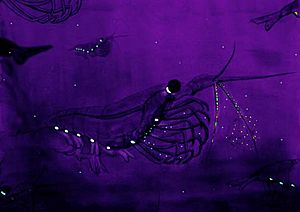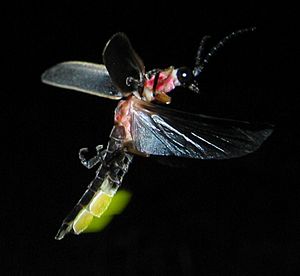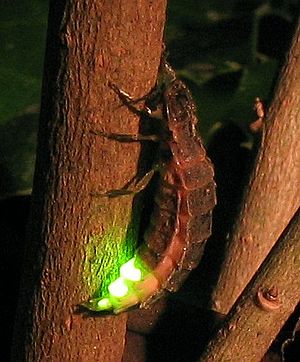Bioluminescence facts for kids
Bioluminescence is when living things make their own light. It's like a natural light show! Often, this happens because a larger animal or plant has tiny living things inside it, like microorganisms, that create the light. These tiny helpers usually live in a special part of the body. Some tiny living things called protists have special parts inside their cells that make light, and some bacteria can glow too.
Bioluminescence is a chemical process. This means special chemicals mix together and create energy, which then comes out as visible light. This amazing ability has developed many times in different creatures throughout evolution.
To make light, a special energy source called ATP (adenosine tri-phosphate) reacts with a chemical called luciferin. An enzyme, which is a type of protein, called luciferase helps this reaction happen. This creates a new mix of chemicals that then combines with oxygen. This final step produces a very bright, glowing compound.
Some types of bacteria called Gamma Proteobacteria are very good at making light. Making light is actually just an extra part of their normal body processes. All chemical reactions make a tiny bit of light, but when a lot more light is made, we can see it. For bacteria, making light might have first helped them get rid of too much oxygen, which can be harmful.
Contents
Light in the Ocean
Bioluminescence is mostly found in the ocean. It's the main source of light in the deep sea, which is the biggest living space on Earth! But you almost never see bioluminescence in fresh water, like lakes or rivers.
You can find glowing creatures in the sea at all levels: tiny floating plankton, animals swimming in the open water (called pelagic animals), and creatures living on the seafloor (called benthic organisms). Some groups of plankton, like dinoflagellates and ctenophores (also known as comb jellies), have many species that glow. Most deep-sea animals use bioluminescence in some way. Usually, the light they make is blue or green. These colors travel through seawater the best.
Why Animals Glow
Animals use bioluminescence for many reasons. It can help them hide, find food, attract a mate, or even escape from danger!
Hiding with Light
Some types of squid use light from bacteria to hide. This is called counterillumination camouflage. They match their own light to the light coming from above them, so they blend in with the sky when seen from below. These animals have special light organs that control how bright their glow is, making them perfectly hidden.
Attracting Others

Bioluminescence can be a lure to attract prey. Several deep-sea fish, like the anglerfish, use a dangling light on their head. This light attracts smaller animals close enough for the fish to catch them.
The Cookiecutter shark uses bioluminescence for camouflage, but it has a small dark patch on its belly. This dark patch looks like a small fish to bigger fish like tuna and mackerel swimming below. When these big fish try to eat the "small fish," the shark bites them, taking out a round chunk of flesh.
Dinoflagellates have a clever way of using light. If a predator tries to eat them, the dinoflagellate glows. This bright flash then attracts even bigger predators, which might eat the first predator! This helps the dinoflagellate escape.
Attracting mates is another important use of bioluminescence. This is famous in fireflies, which flash their abdomens in special patterns to find partners during mating season. In the ocean, this has been clearly seen in some small crustaceans called ostracods, but it might be common in many other marine animals too.
Scaring Away Predators
Some squid and small crustaceans use bioluminescence like many squid use ink. They shoot out a cloud of light. This bright cloud confuses or scares away a predator, giving the squid or crustacean time to escape safely. Also, all firefly larvae glow to warn predators that they taste bad.
Bioluminescence in Science

Scientists are very interested in bioluminescent organisms. The systems that make light, like the luciferin and luciferase chemicals, are used a lot in genetic engineering. They are also used in medical research to make certain cells visible. For example, luciferin can be added to tiny molecules and cells to make them glow under a microscope. This helps scientists see things they couldn't before. This technology is used in hospitals for blood tests to find things like viruses, cancer cells, and hormones.
Designers are also studying the special light-producing organs, called photophores, found in glowing creatures. They hope to learn how to create new types of lights.
Animals and Plants That Glow
Here are some examples of living things that can make their own light:
Land Organisms
- Animals:
- Arthropods (insects and similar creatures)
- Fireflies
- Click beetles
- Glow worms (including railroad worms)
- Certain types of flies
- Some centipedes, like Geophilus carpophagus
- Some millipedes, like Motyxia
- Arthropods (insects and similar creatures)
- A land mollusc (a type of snail)
- Quantula striata
- Annelids (segmented worms)
- Fungi – There are 71 known species of glowing fungi, including types of Armillaria, Omphalotus, Mycena, Gerronema, and Pleurotus.
- Mushrooms (sometimes called Foxfire)
- Jack O'Lantern mushroom (Omphalotus olearius)
- Ghost fungus (Omphalotus nidiformis)
- Honey mushroom
- Panellus stipticus
- Mushrooms (sometimes called Foxfire)
Fish
- Anglerfish
- Cookie-cutter shark
- Flashlight fish
- Gulper eel
- Lanternfish
- Marine hatchetfish
- Midshipman fish
- Pineconefish
- Viperfish
Fireflies
Even though they are called fireflies, they are actually a type of beetle! They use a special chemical reaction with luciferin to make their famous greenish flashing light. This flashing might warn predators that they are not good to eat, but its main job is to help male and female fireflies find each other to mate.
Ocean Invertebrates
- Many Cnidaria (like jellyfish and corals)
- Certain Ctenophores or "comb jellies"
- Certain echinoderms (like some types of starfish)
- Certain crustacea (like crabs and shrimp)
- Two species of chaetognaths
- Certain molluscs (like snails and squid)
- Certain clams and other bivalves
- Certain nudibranchs (sea slugs)
- Octopods
- Bolitaenidae
- Order Teuthida (true squid)
- Colossal Squid
- Mastigoteuthidae
- Sepiolidae
- Sparkling Enope Squid
- Vampire squid
Tiny Organisms
- Dinoflagellates (e.g., Noctiluca scintillans, Pyrodimium bahamense). These are tiny, one-celled organisms that can make the ocean glow at night.
- Vibrionaceae (e.g., Vibrio fischeri, Vibrio harveyi, Vibrio phosphoreum). These are types of bacteria.
- Members of the marine bacterial family Shewanellaceae, Shewanella hanedai and Shewanella woodyi, also glow.
Images for kids
-
A scientist named Osamu Shimomura found the glowing protein aequorin from the crystal jelly Aequorea victoria in 1961.
-
How counterillumination camouflage works in the firefly squid, Watasenia scintillans. When a predator looks up from below, the squid's glow helps it blend in with the light from the ocean surface.
-
Pyrosoma, a colony of tiny animals called tunicates. Each tiny animal in the colony flashes a blue-green light.
-
A deep-sea anglerfish, Bufoceratias wedli, showing its glowing lure, called an esca.
-
The black dragonfish, Malacosteus niger, flashing its light organs, which show a red glow.
See also
 In Spanish: Bioluminiscencia para niños
In Spanish: Bioluminiscencia para niños















